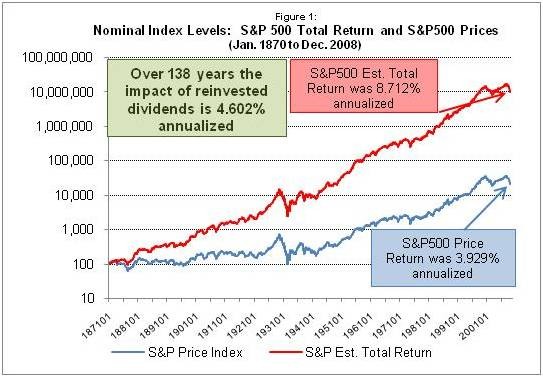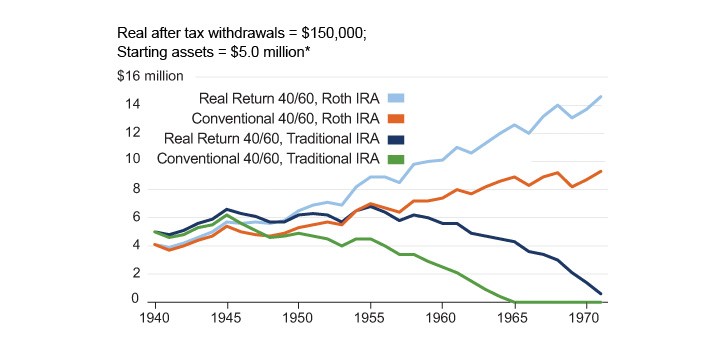Inflation s Impact On Stock Returns
Post on: 16 Март, 2015 No Comment

Investors, the Federal Reserve and businesses constantly monitor and worry about the level of inflation. Inflation — the rise in price of goods and services — reduces the purchasing power each unit of currency can buy. Rising inflation has an insidious effect: input prices are higher, consumers can purchase fewer goods, revenues and profits decline, and the economy slows for a time until a steady state is reached.
This negative impact of rising inflation keeps the Fed diligent and focused on detecting early warning signs to anticipate any unexpected rise in inflation. But once the unanticipated inflation works its way through the levels of economy, the impact of a higher steady state of inflation can have varying effects. In other words, the unexpected rise of inflation is generally considered the most painful, as it takes companies several quarters to be able to pass along higher input costs to consumers. Likewise, consumers feel the unexpected “pinch” when goods and services cost more. However, businesses and consumers eventually become “acclimated” to the new pricing environment, and then even when a new higher steady state is reached, the expected inflation that may occur thereafter can result in consumers spending more cash. These consumers become less likely to hold cash because its value over time decreases with inflation. For investors, this can cause confusion, since inflation appears to impact the economy and stock prices, but not at the same rate.
High inflation can be good, as it can stimulate some job growth. But high inflation can also impact corporate profits through higher input costs. This causes corporations to worry about the future and stop hiring, negatively impacting the standard of living of individuals, especially those on fixed incomes. Because there is no one good answer, individual investors must sift through the confusion to make wise decisions on how to invest in periods of inflation. Different groups of stocks seem to perform better during periods of high inflation.
Inflation and Stock Returns
Examining historical returns data during periods of high and low inflation can provide some clarity for investors. Numerous studies have looked at the impact of inflation on stock returns. Unfortunately, these studies have produced conflicting results when several factors are taken into account — namely geography and time period. Most studies conclude that expected inflation can either positively or negatively impact stocks, depending on the ability to hedge and the government’s monetary policy. But unexpected inflation did show more conclusive findings, most notably being a strong positive correlation to stock returns during economic contractions, demonstrating that the timing of the economic cycle is particularly important for investors to gauge the impact on stock returns. This correlation is also thought to stem from the fact that unexpected inflation contains new information about future prices. Similarly, greater volatility of stock movements was correlated with higher inflation rates.
The data has proven this in geographic regions where higher inflation is generally linked to emerging countries, and the volatility of stocks is greater in these regions than in developed markets. Since the 1930s, the research suggests that almost every country suffered the worst real returns during high inflation periods. Real returns are actual returns minus inflation. When examining S&P 500 returns by decade and adjusted for inflation, the results show that the highest real returns occur when inflation is 2 to 3%. Inflation greater than or less than the 2 to 3% tends to signal a U.S. macroeconomic environment with larger issues that have varying impacts on stocks. Perhaps more important than the actual returns are the volatility of returns that inflation causes and how to invest in that environment.
Growth Vs. Value Stock Performance and Inflation
Stocks are often broken down into subcategories of value and growth. Value stocks have strong current cash flows that will slow over time, while growth stocks have little or no cash flows today but will gradually increase over time .
Therefore, when valuing stocks using the discounted cash flow method, in times of rising interest rates growth stocks are negatively impacted far more than value stocks. Since interest rates and inflation tend to move together, the corollary is that in times of high inflation, growth stocks will be more negatively impacted. This suggests a positive correlation between inflation and the return on value stocks and a negative one for growth stocks .

This explains the strength of value stocks during high inflation, like in 1973-74, and the strength of growth stocks during the early 1930s when deflation occurred, as well as during the 1990s when inflation was steadily moving downward. Interestingly, the rate of change in inflation does not impact returns of value versus growth stocks as much as the absolute level. The thought is that investors may overshoot their future growth expectations and upwardly misprice growth stocks. In other words, investors fail to recognize when growth stocks become value stocks, and the downward impact on growth stocks is harsh.
Income-Generating Stocks and Inflation
However, the price of dividend-paying stocks is impacted by inflation, similar to the way bonds are affected by increasing rates, and the prices generally decline. So owning dividend-paying stocks in times of increasing inflation usually means the stock prices will decline. But investors looking to take positions in dividend-yielding stocks are given the opportunity to buy them cheap when inflation is rising, providing attractive entry points.
The Bottom Line
Investors try to anticipate the factors that impact portfolio performance and make decisions based on their expectations. Inflation is one of those factors that affects a portfolio. In theory, stocks should provide some hedge against inflation, because a company’s revenues and profits should grow at the same rate as inflation, after a period of adjustment. However, inflation’s varying impact on stocks confuses the decision to trade positions already held or to take new positions. In the U.S. market, the historical proof is noisy, but it does show a correlation to high inflation and lower returns for the overall market in most periods.
When stocks are divided into growth and value categories, the evidence is clearer that value stocks perform better in high inflation periods and growth stocks perform better during low inflation. One way investors can predict expected inflation is to analyze the commodity markets, although the tendency is to think that if commodity prices are rising, stocks should rise, since companies “produce” commodities. However, often, high commodity prices squeeze profits, which in turn reduces stock returns. Therefore, following the commodity market may provide insight into future inflation rates.














